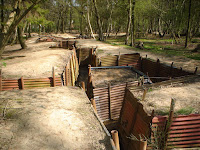Field Guns at Firepower used by Nothumbrian Gunner unitsBLC 15 PounderOriginally issued to Territorial Force (TF)Royal Field Artillery units in 1908. The TF RFA Brigades deployed with this gun to the Western Front in April 1915. It was replaced between October 1915 and January 1916.

1st Northumbrian Brigade RFA (TF)
2nd Northumbrian Brigade RFA (TF)
3rd Northumbrian Brigade RFA (TF)
Ordnance QF 18 PounderThis was the standard Field Gun for the Royal Field Artillery in WW1. All Regular Brigades used this gun throughout the war, TF units receiving it between October 1915 to January 1916. All new Army unites fired the 18 pounder.

1st Northumbrian Brigade RFA (TF)- 250 Brigade RFA
2nd Northumbrian Brigade RFA (TF)- 251 Brigade RFA
3rd Northumbrian Brigade RFA (TF) -252 Brigade RFA
315 Brigade RFA / 316 Brigade RFA / 317 Brigade RFA
160 (Weardside) Brigade RFA
4.5 inch Howitzer.The Territorial Force gunners used the 5" Howitzer from 1908 to 1915 when it was replaced with the 4.5 inch Howitzer.The 4,5 inch Howitzer was the standard Regular Army gun.

4th Northumbrian (County of Durham) Howitzer Brigade RFA (TF)
D/250 Battery / D/252 Battery / D/61 Battery
25 PounderStandard gun for Field Regiments in WW2. The Territorial Gunners re-equipped with this gun during WW2.

72nd (Northumbrian) Field Regiment TA (TA)
74th (Northumbrian) Field Regiment TA (TA)
124th (Northumbrian) Field Regiment TA (TA)
2 Pounder Anti/Tank GunThe Northumberland Hussars re-rolled as anti-tank gunners in September 1939 on mobilisation, 125 Regiment converting in December 1939.

102 (Northumberland Hussars) ATk Regiment RHA (TA)
125th (Northumbrian) Anti-Tank Regiment RA (TA)
5.5 inch GunThe 5.5in was the first gun of 101 Regiment, being used from the Regiment's formation in 1967 till 1980.

101 (Medium) Regiment RA (V)
105mm Light GunThe 105mm Light Gun was used by 101 Regiment between 1980 and 1992. The Regiment supported 15 Infantry Brigade as part of the 2nd Divisions rear area defence in Germany during the Cold War.

101 (Field) Regiment RA (V)
FH70The FH 70 was used by 101 Regiment from 1992 till 1997, when the Regiment converted to MLRS. The Regiment was rolled as a General Support Regiment in the 1st Armoured Division

101 Regiment RA (V)














































































